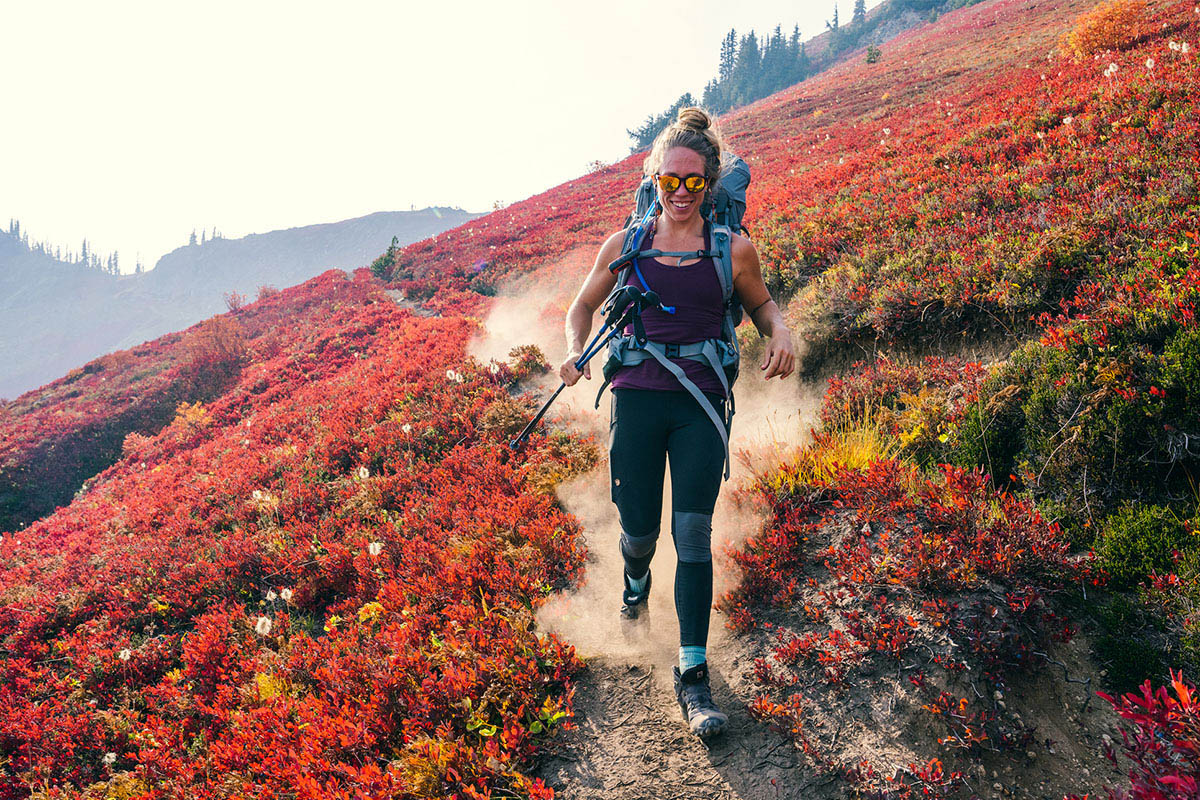
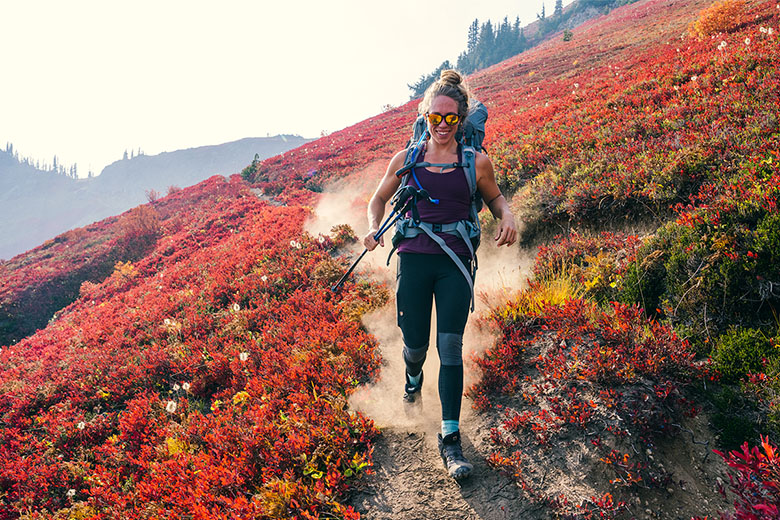
While hiking pants have come a long way since their inception, many women still struggle to find a good all-around fit with the classic hard-snap waistbands and stiffer materials. Hiking leggings are a versatile, comfortable alternative, providing a dose of added support thanks to their snug fit that often includes elastane for light compression. Our top hiking leggings aren’t your standard athleisure fare though—they’re built to stand up to the rigors of outdoor use with quality materials that hold up well both on and off the trail, along with functional storage for stashing the essentials. Below we break down the best women’s hiking leggings of 2025, from technical designs for peak-bagging and rock climbing to fleece-lined options for cold-weather adventures. For more information, see our buying advice and comparison table below the picks, along with details about our testing process. And for a wider assortment of styles, check out our article on the best women’s hiking pants.
Editor's note: We updated this guide on August 20, 2025, to add the Gorewear R5 Windstopper Tights as our pick for a cold-weather legging, as well as the On Trek Tight to our lineup. We also removed discontinued leggings from Arc'teryx and Athleta, and combed through the guide to ensure prices, colorways, and products were current at the time of publishing.
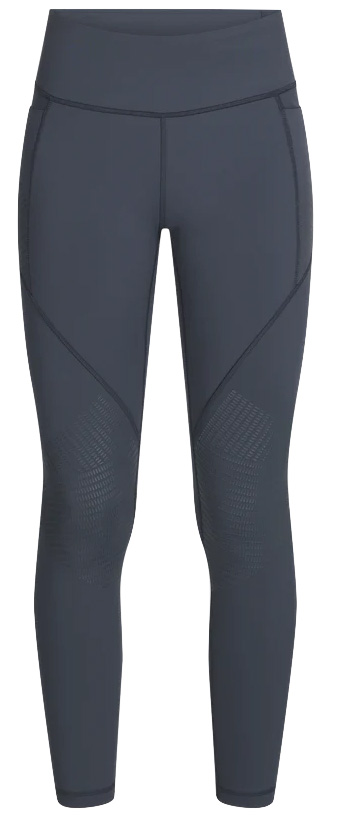 Materials: 74% nylon, 26% Lycra
Materials: 74% nylon, 26% Lycra
Weight: 8.3 oz.
Inseam: 25 in.
Pockets: 1 waistband, 2 drop-in thigh
What we like: Easy to move in, decently breathable, and not overly technical for wearing casually.
What we don’t: No zippered storage or DWR coating; our pair has developed noticeable pilling along the seams.
Technically designed for climbing, Outdoor Research’s Ad-Vantage Leggings were quick to win us over during a week of hiking and backpacking in the Pacific Northwest. The first thing that stood out was fit: The Ad-Vantage features a wide waistband that’s supportive but not restrictive, stays in place, and goes largely unnoticed underneath a pack hipbelt or climbing harness. Durability is another highlight thanks to overlays along the knees and sides of the hips, which do a great job fending off snags and tears. And with a healthy dose of stretch, the Ad-Vantage is very easy to move in—not too surprising since it's built for climbing—and comfortable to wear all day.
While not particularly everyday-friendly, the Ad-Vantage Leggings don’t look out of place if you want to grab a bite to eat after a hike or run a few errands after hitting the climbing gym. The lack of zippered storage might be a dealbreaker for some, but we’ve found the drop-in pockets to be very secure. In fact, we’ve forgotten to take our phone out of our pocket while bouldering several times, and it’s never threatened to slip out. It’s worth noting that our pair has developed noticeable pilling along the seams, but that’s not too shabby given what we’ve put it through over the last few seasons. Finally, we wish OR had tacked on a durable water-repellent (DWR) coating for fending off light moisture, although the pants are surprisingly quick to dry. And this is telling: We still reach for the Ad-Vantage more frequently than any other leggings in our closet—even if they look a little worn. For $10 less, OR also offers the Vantage 7/8 Leggings, which are similarly built but without the abrasion-resistant overlays.
See the Outdoor Research Ad-Vantage
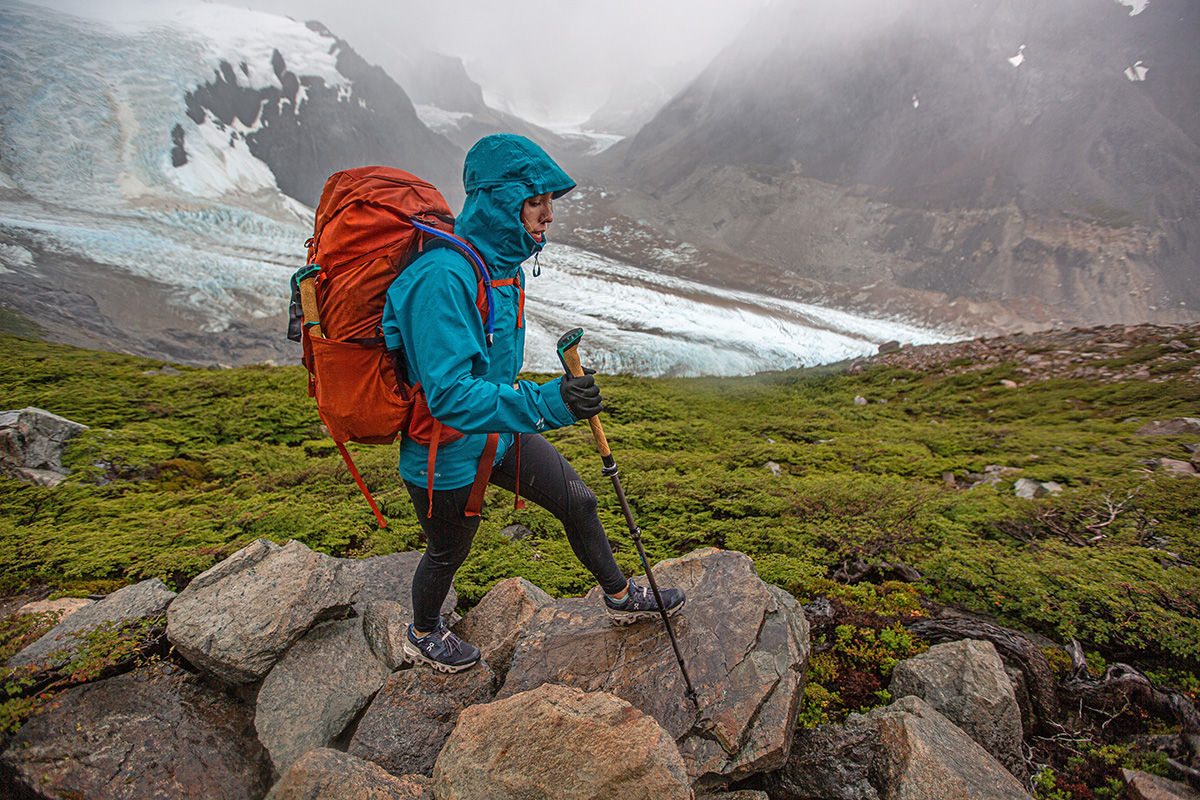
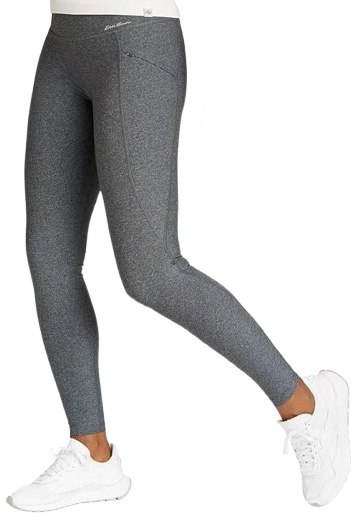 Materials: 88% polyester, 12% spandex
Materials: 88% polyester, 12% spandex
Weight: 11.1 oz.
Inseam: 28 in. (also available in 26- and 31-in. inseams)
Pockets: 2 zippered thigh
What we like: Highly supportive, functional zippered storage, and often available at a discount.
What we don’t: Thick fabric is great for warmth but less so for breathability; fit was a little tight and restrictive in our usual size.
Right off the bat, we’ll note that the Eddie Bauer Trail Tight High-Rise Leggings retail for the same price as the Ad-Vantage above, which at first glance doesn’t seem like a screaming deal. But diving a little deeper, you can almost always find multiple colorways available at a discount—at the time of publishing, we’re seeing options as low as just $25 on Amazon. It’s for this reason that the Trail Tight ranks so highly on our list, and performance far exceeds most of the off-brand competition that dominates the budget market. In testing, we came away impressed by the Trail Tight’s supportive, compression-like feel, along with the thoughtful storage layout that includes one large, zippered pocket at either thigh. Not to mention, the pants are available in four sizing options—including petite (26 in. inseam), regular (28 in.), tall (31 in.), and plus sizes up to 3X—to accommodate a wider range of body types.
What’s not to like with the Eddie Bauer Trail Tight High-Rise Leggings? First, the fit was slightly tight and restrictive in our usual size, especially around the waist, although some users report needing to size down. In other words, it’s a good idea to try the tights on in person or purchase from a retailer with a generous return policy. Second, while the thick construction is a boon on chilly mornings and evenings at camp, we’d opt for something lighter and airier (like the Patagonia Maipo below) in warm to hot conditions. Finally, the zipper pulls are small and hard to manipulate with cold or gloved hands. Gripes aside, the Eddie Bauer Trail Tight Leggings have held up well for us throughout multiple seasons of use and stand out as a solid value if you can score them for less than the full MSRP.
See the Eddie Bauer Trail Tight High-Rise
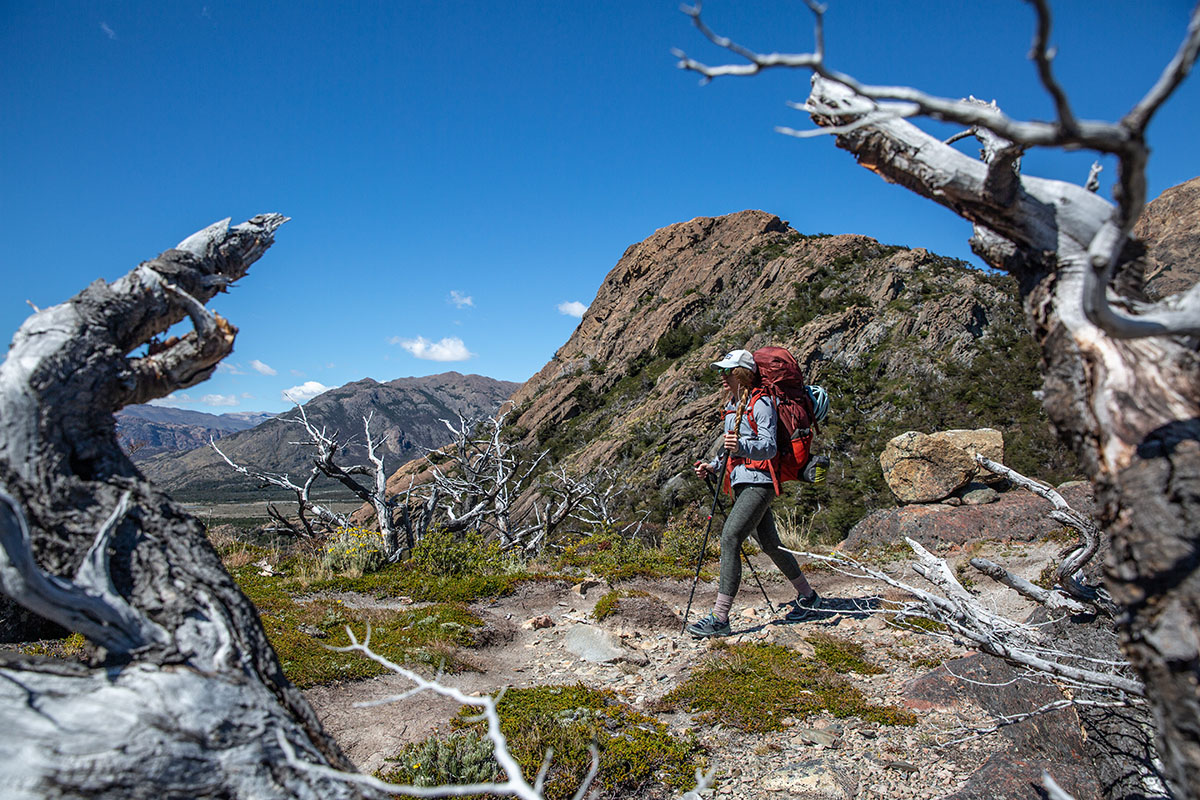
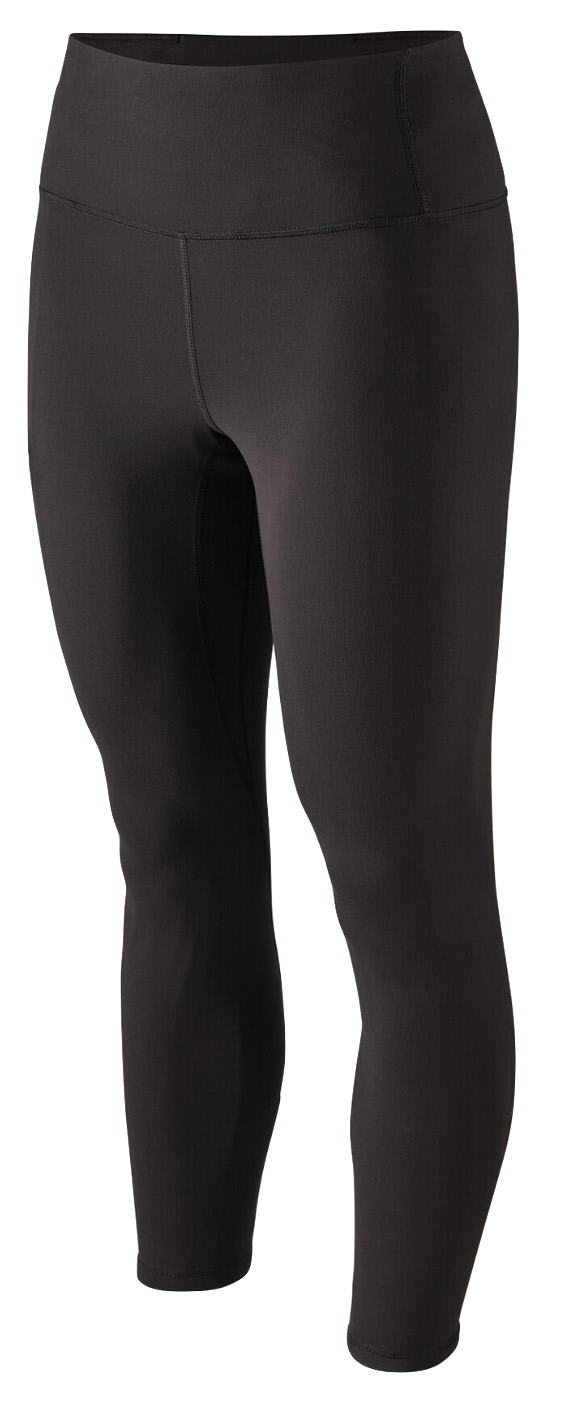 Materials: 81% nylon, 19% spandex
Materials: 81% nylon, 19% spandex
Weight: 5.3 oz.
Inseam: 25 in.
Pockets: 1 waistband
What we like: Soft, airy fabrics and great everyday appeal.
What we don’t: Lacking in storage and durability.
For summertime adventures, we turn to lightweight designs that keep air flowing, and Patagonia’s Maipo 7/8 Tights fit the bill nicely. Constructed with soft, quick-drying fabrics, the Maipo offers excellent breathability and a barely-there feel that lines up with the scant, 5.3-ounce weight. Mobility is also excellent, allowing us to high-step over deadfall, hop between boulders, and perform camp chores with ease. And the wide, high-rise waistband offers a nice dose of support while sliding seamlessly underneath a pack hipbelt. The cherry on top: The Maipo 7/8 Tights cross over well for wearing casually and are built with a strong sustainability slant (the nylon is sourced from recycled fishing nets).
We brought the Maipo 7/8 Tights on a backpacking trip in Chilean Patagonia and came away with mixed feelings regarding performance. On one hand, they were a great match for the temperatures we experienced, keeping us perfectly comfortable into the mid-80s Fahrenheit. They were also quick to dry after a couple accidental dousings in high water crossings. However, in addition to lacking a spot to store our smartphone (there is a “Stash” version with improved storage available for $20 more), the Maipo is decidedly lacking in durability for off-trail adventures. To be fair, our trip involved a lot more bushwhacking than we were anticipating, and the Maipo emerged without any major holes, but there’s a noticeable amount of pilling along the seams and several snags along the lower legs from encounters with rogue branches and brush. In other words, the Maipo is a bit of a one-trick pony, but if summer-ready breathability is at the top of your priority list, it’s certainly worth considering.
See the Patagonia Maipo 7/8 Tights
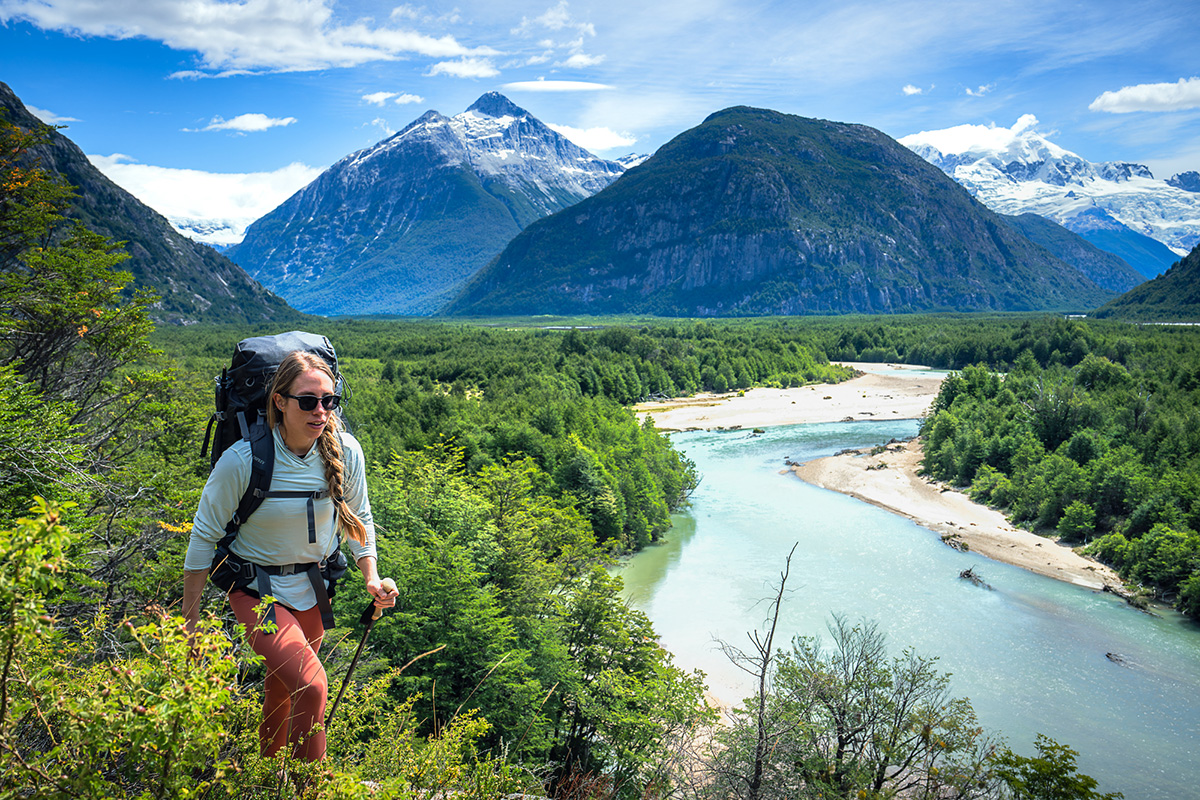
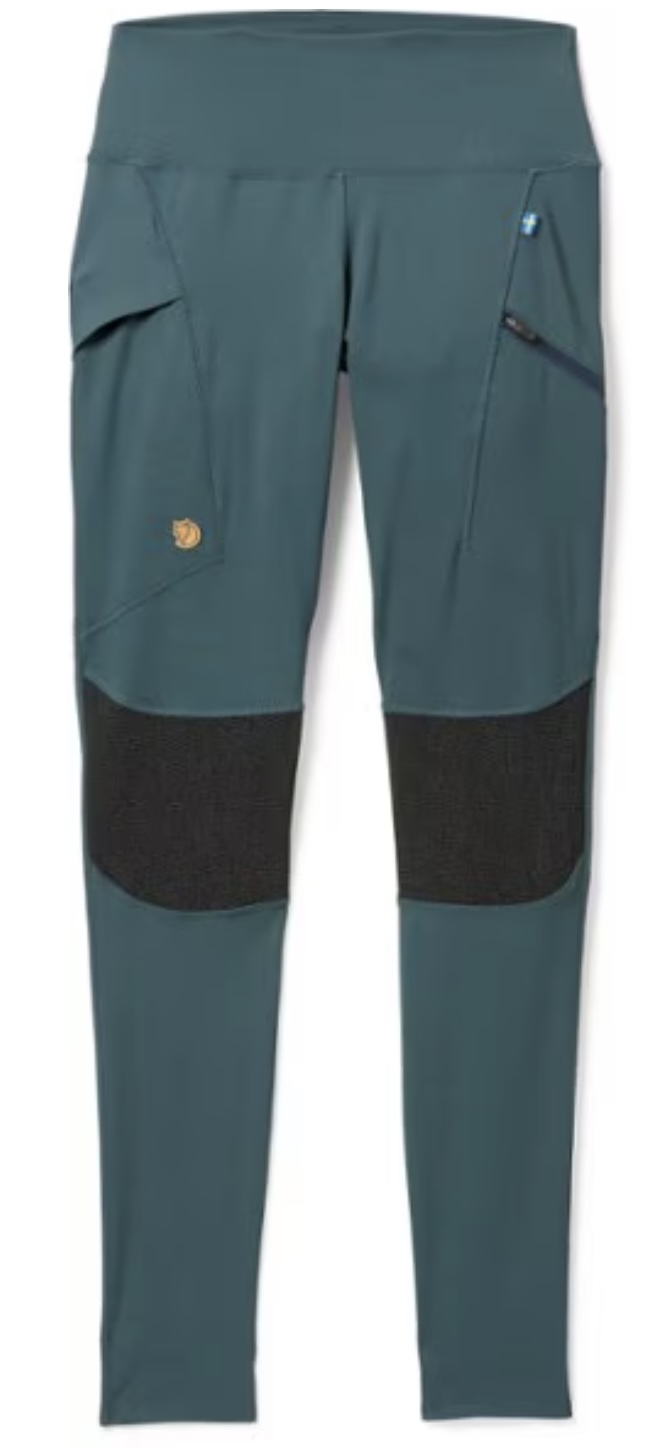 Materials: 70% polyester, 30% elastane (body); 62% polyamide, 16% aramid, 12% elastane, 10% polyester (reinforcements)
Materials: 70% polyester, 30% elastane (body); 62% polyamide, 16% aramid, 12% elastane, 10% polyester (reinforcements)
Weight: 9.3 oz.
Inseam: 32 in.
Pockets: 1 zippered thigh, 1 drop-in thigh
What we like: Class-leading durability and great support.
What we don’t: Pricey, thick, and very technical in both look and feel.
The Outdoor Research Ad-Vantage Leggings above will get the job done for most hikers, but Fjallraven takes performance to the next level with their Abisko Trekking Tights HD. At a steep $175, these technical leggings don’t come cheap, but as we’ve come to expect from Fjallraven, they’re built with a clear focus on quality and a keen attention to detail. In terms of construction, you get great freedom of movement with a stretchy mix of materials, as well as reinforced panels on the knees and butt for guarding against sharp rocks and other abrasive surfaces. The result is a legging that’s purpose-built for the mountains and capable of withstanding serious use and abuse. In fact, the Abisko Trekking Tights have served as our go-to climbing pants for almost four full seasons—on rock ranging from unpolished granite to sharp limestone—with very little wear to show for it other than a small tear near one of the pockets from a swinging fall.
Keep in mind that the Abisko Trekking Tights HD are overkill for on-trail objectives and wearing casually, and price is a deterring factor for many. The reinforced panels are nice, and we like the storage layout—one large pocket on the right leg and a smaller zippered pocket on the left, both of which are smartphone-friendly—but you’ll need to get out a lot to make the investment worth it. Additionally, the relatively thick and highly durable fabrics translate to subpar breathability in the heat. But overall quality and performance are top-notch, and the Abisko Trekking is also available in a few other versions, including the 7/8-length “Pro” ($150), cold-weather-ready Abisko Värm ($175), and standard Abisko ($120) without reinforcements.
See the Fjallraven Abisko Trekking Tights HD
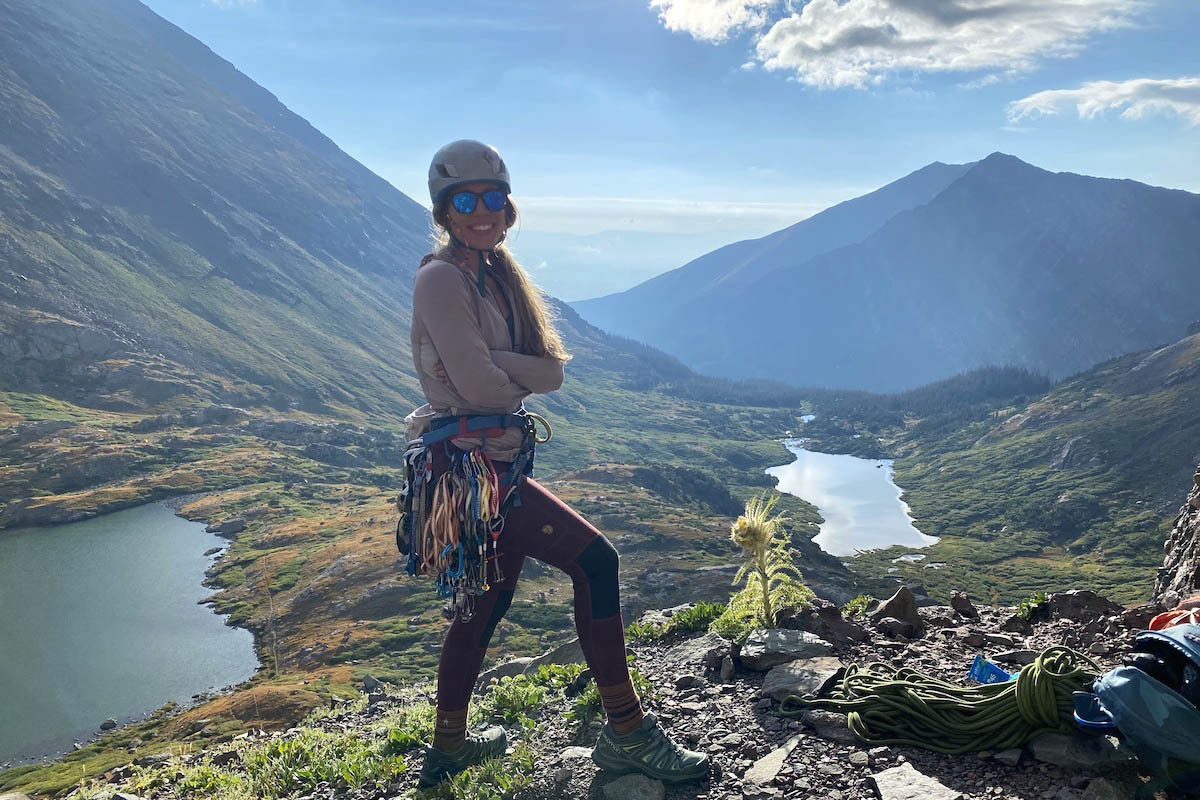
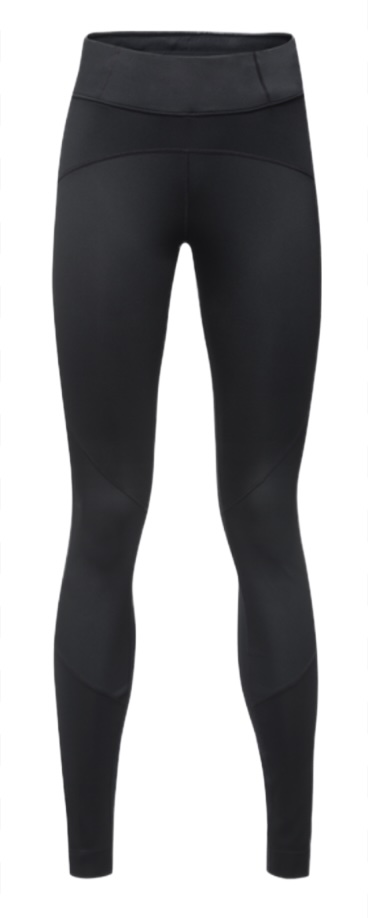 Materials: 92% polyester, 8% elastane (body); 91% polyester, 9% elastane (reinforcements)
Materials: 92% polyester, 8% elastane (body); 91% polyester, 9% elastane (reinforcements)
Weight: 8.6 oz.
Inseam: 30.75 in.
Pockets: 1 drop-in thigh, 1 zippered back
What we like: A 3-layer Windstopper construction keeps the cold at bay.
What we don’t: Windproof material is hard to keep from sliding down; expensive.
Fully windproof tights can be polarizing, but these winter-ready leggings from Gorewear use sections of strategically placed 3-layer Windstopper laminate that help reduce wind chill without impacting range of motion. The body-mapped, windproof material is incorporated around the thighs and groin, adding an extra layer of protection where you're more likely to feel the wind. The Windstopper material also has a high level of water resistance, and the main part of the tights has a dual-layer build that allows for warmth without sacrificing mobility. These leggings are pricey, but we've been impressed with their temperature-regulating comfort when running and hiking, and the 31.75-inch inseam provides plenty of coverage. Finally, we love the low-profile zipper to help take them on and off.
Gorewear apparel rarely comes cheap, and these are quite expensive at $150, even for a protective pair of thermal tights. We haven't noticed any durability or pilling issues though, and we've been wearing some version of these consistently for the past two winters. You do lose some of the compression and conforming fit with the stiffer windproof panels, and they can be trickier to keep from sliding down compared to leggings with the same material throughout, or anything with higher levels of elastane. That said, we've loved these as an alternative to thicker, fleece-lined pairs, and winter hikers heading out above treeline will appreciate the streamlined protection. If you're looking to save cash on winter tights, we also like Topo Designs’ StayWarm Trail Legging ($109) and REI's Swiftland Thermal Tights ($85).
See the Gorewear R5 Windstopper Tights
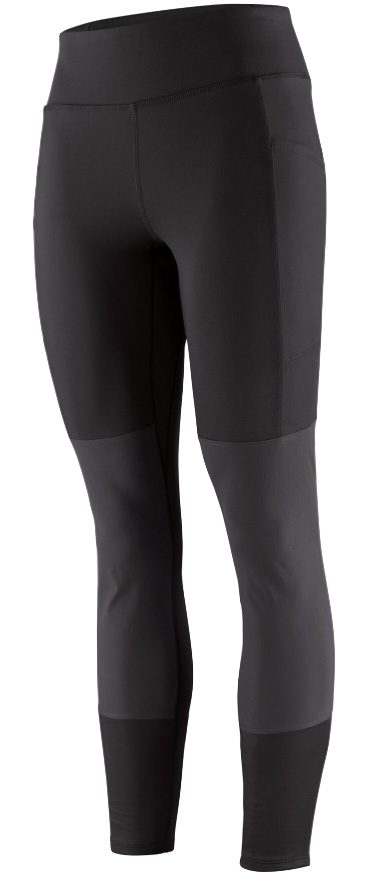 Materials: 87% polyester, 13% spandex
Materials: 87% polyester, 13% spandex
Weight: 10.7 oz.
Inseam: 28 in.
Pockets: 2 drop-in thigh, 1 zippered thigh
What we like: Great comfort, storage, and durability in a sustainably built package.
What we don’t: Not particularly quick to dry or breathable enough for hot-weather hiking.
Patagonia dominates the hiking apparel market, and their Pack Out Hike Tights are a case in point. Like the Fjallraven Abisko above and On Trek Tight below, the Pack Out Hike features reinforced panels at the knees and seat that add a nice dose of assurance when brushing up against rocks, trees, or pokey shrubs. The rear panel is also great when sitting down, providing a nice barrier against damp surfaces. The rest of the build is equally well executed, including a thoughtful storage layout, soft but durable materials that hold their shape over time, and a wide elastic waistband that stays in place and limits bunching and friction under a hipbelt. And as we’ve come to expect from Patagonia, the Pack Out Hike Tights score high marks in sustainability thanks to the use of recycled materials and a PFAS-free DWR coating that forgoes the use of harmful “forever chemicals.”
The Pack Out Hike Tights were in the running for our top spot, but there are a couple of reasons we rank the Outdoor Research Ad-Vantage higher. First is price, with the Patagonia tights coming in $30 more than the OR. The Pack Out Hike Tights are also thicker, which could be a pro or con depending on your intended use. For us, the leggings’ reduced breathability led to overheating on an unseasonably warm backpacking trip in Patagonia. They were also slow to dry after an accidental dousing during a river crossing. Finally, while we love the reinforcements, they do give the tights a decidedly technical look, especially in the lighter colorways. Still, the Pack Out Hike’s well-rounded build and nicely sorted feature set earn it a spot high on our list this season. And if you like the design but not the techy appearance, check out the standard Pack Out Tights ($119), which omit the wear-resistant panels.
See the Patagonia Pack Out Hike Tights
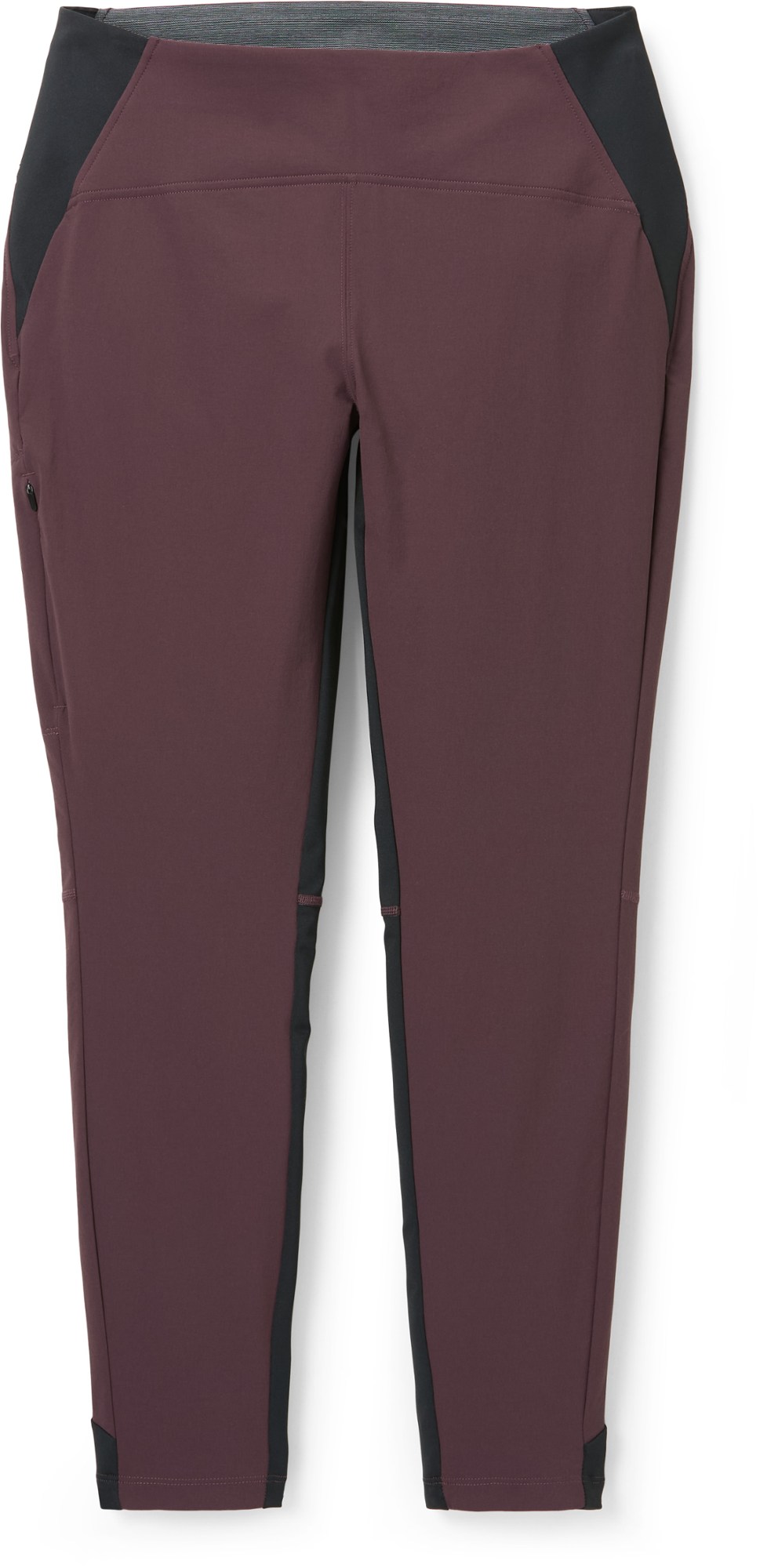 Materials: 88% nylon, 12% elastane
Materials: 88% nylon, 12% elastane
Weight: 7.4 oz.
Inseam: 28 in.
Pockets: 1 zippered thigh
What we like: Great durability and weather resistance for technical objectives; one of the cheapest options here.
What we don’t: Limited “give” and not the most comfortable design.
Mountain Hardwear specializes in technical clothing and equipment for climbing and mountaineering, and their Chockstone Tight carries the torch. Featuring a double-weave softshell fabric, the Chockstone does a good job fending off abrasion and wind, making it just as capable while climbing as it is on the hike in. It also features UPF 50 sun protection and a water-repellent finish to protect against light moisture. Tack on a price tag of just $85 (and currently on sale at the time of publishing), and the Chockstone stands out as a great value for such a mountain-ready design.
It's not all good news with the Chockstone, however. First, the fabric doesn’t offer much “give” and has a stiffer feel as a result. The tights are also limited on storage with just a single zippered pocket at the right thigh, and the black panels at the hips, ankles, and inside of each leg put them squarely in the performance category. Like the Abisko and Pack Out Hike Tights above, the Chockstone wouldn’t be our first choice for wearing casually. And we’d be remiss not to touch on fit, which we found to be spot-on in most areas but with an excess amount of fabric at the rear. Finally, the interior lacks the seamless comfort of alternatives like the Patagonia Maipo above, with some users reporting noticeable chafing and discomfort along the inner legs (we didn't experience these issues). But if you can try them on before you buy and don't mind sacrificing some comfort in the name of savings, the Chockstone leggings still have a lot going for them.
See the Mountain Hardwear Chockstone Tight
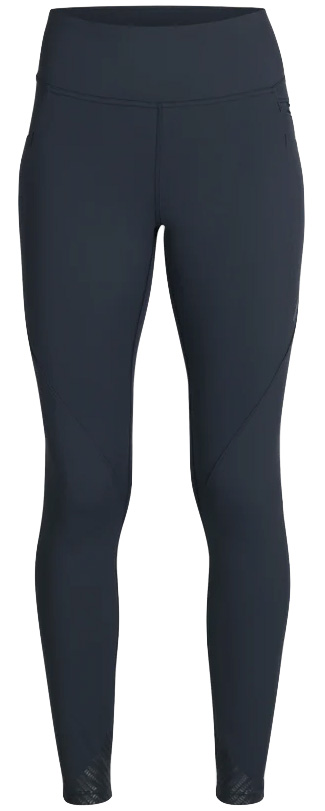 Materials: 74% nylon, 26% Lycra (waistband and front of legs); 86% nylon, 14% spandex (back of legs)
Materials: 74% nylon, 26% Lycra (waistband and front of legs); 86% nylon, 14% spandex (back of legs)
Weight: 8.8 oz.
Inseam: 31 in.
Pockets: 2 drop-in thigh, 1 zippered hip, 1 waistband
What we like: Ferrosi fabric is highly durable and wind-resistant.
What we don’t: Prohibitively small ankle openings and waistband; not a standout in comfort.
The second Outdoor Research design to make our list this season is the Ferrosi Hybrid, which offers a step up in performance compared to the top-ranked Ad-Vantage. For around $10 more, the Ferrosi Hybrid uses a “mapped” construction that helps balance conflicting priorities: The front of the legs features OR’s knit Vantage fabric that’s breathable, quick to dry, and boasts UPF 50+ protection for long days in the sun; the back of the legs is made with OR’s well-loved Ferrosi fabric, which we’ve found tough enough to cut the wind and shed light rain but still decently breathable for heart-pumping activities like hiking and climbing. Rounding out the design are overlays at the ankles to guard against snags and tears, along with a very well-sorted storage layout that makes it easy to divvy up the essentials.
However, the Ferrosi Hybrid Leggings do have some drawbacks, the most notable of which is fit. Specifically, we found the openings at the ankle to be prohibitively small, requiring a good amount of force to pull over our feet. It’s worth noting that our tester has high arches, which is likely a contributing factor, but we haven’t experienced this issue with any other leggings. The waistband is also pretty tight and stiff, although the advantage is excellent support (once you get the pants over your hips, that is). Finally, the Ferrosi fabric at the back of the legs is relatively lacking in stretch, which detracts from overall comfort but is nice when sitting down on damp surfaces. These complaints are enough to push the Ferrosi Hybrid Leggings down in our rankings, but we’re often willing to deal with the trade-offs for technical objectives that involve bushwhacking, scrambling, or even multi-pitch climbing.
See the Outdoor Research Ferrosi Hybrid
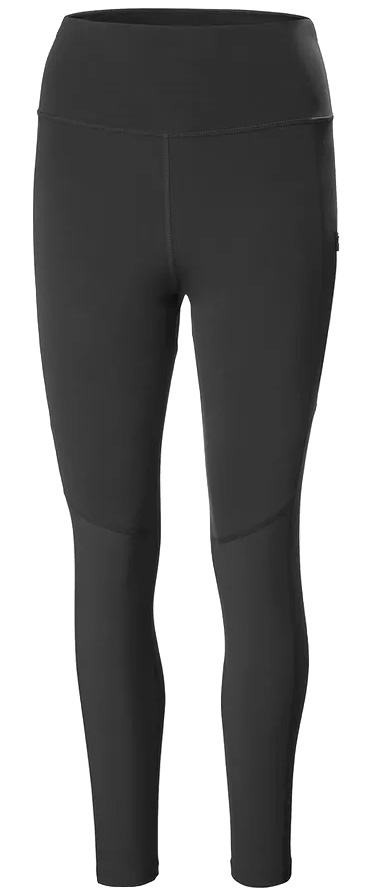 Materials: 66% polyamide, 34% elastane (body); 88% polyamide, 12% elastane (reinforcements)
Materials: 66% polyamide, 34% elastane (body); 88% polyamide, 12% elastane (reinforcements)
Weight: 8.5 oz.
Inseam: 24 in.
Pockets: 1 zippered thigh
What we like: A well-rounded technical design with excellent stretch and a drawcord for adjusting fit at the waist.
What we don’t: Fewer pockets than Patagonia’s Pack Out Hike Tights.
Bearing a strong resemblance to Patagonia’s Pack Out Hike Tights above, Helly Hansen’s Blaze 7/8 is another quality option for those undeterred by the techy appearance. Like the Pack Out Hike, the Blaze features softshell panels protecting the lower legs and butt—great for inspiring confidence when navigating through dense brush or scrambling over boulders and scree to the summit. We also like that the Blaze features a drawcord at the waist, making it one of few designs to offer fit adjustability. Rounding out the design, you get a whopping 34% elastane (the reinforced panels are less stretchy with just 12%) that translates to excellent all-around mobility, along with a zippered pocket at the left hip that’s big enough to swallow a smartphone.
The biggest reason we ranked the Pack Out higher is storage: The Patagonia pants feature three pockets compared to the Blaze’s one, including two drop-in pockets and a single zippered pocket. They’re also offered in a wider colorway selection and hold up slightly better over the long term, in our experience. But the Blaze does win out in several areas, including added stretch, 2-ounce weight savings, and $9 cost savings. In other words, while the lack of storage can be a dealbreaker, we consider the Blaze to be very well-rounded overall. For a step down in price, we also like Helly Hansen’s Roam Trail Leggings ($80), which are less technical but more everyday-friendly than the Blaze.
See the Helly Hansen Blaze 7/8 Hiking Tights
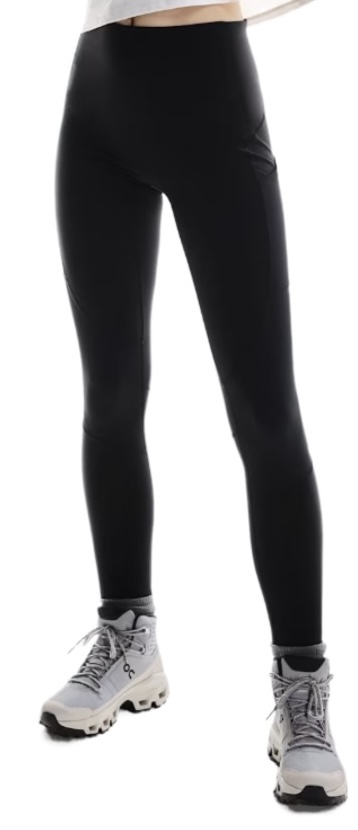 Materials: 59% polyamide, 41% elastane (body); 100% polyamide (reinforcements)
Materials: 59% polyamide, 41% elastane (body); 100% polyamide (reinforcements)
Weight: 6.0 oz.
Inseam: 27 in.
Pockets: 2 drop-in pockets, 1 zippered back
What we like: Tons of secure storage and offered in multiple inseam lengths.
What we don’t: High level of compression can feel constricting; expensive.
These sleek-but-tough leggings are ideal for wearing under a pack, with their high-rise bonded waistband that has virtually no distinction from the rest of the leggings. This means we feel the waistband less than we would otherwise, especially for a pair of leggings made with such a high percentage of elastane. Some hikers will find the compression to be too much, while others will appreciate the security. The 41% stretch material does make these excellent for anyone looking for sleek compression and a durable, high-stretch fit, and the range of motion is fantastic, even with the reinforced material sections in areas of high abrasion. These leggings are also low-profile, incredibly tough, stay up well under a pack, and have all the technical elements we like without looking too over the top.
Aside from the somewhat overly compressive build, cost is the On Trek Tight's primary detractor. They're the second-priciest leggings on our list, and have fewer components than the more expensive Fjallraven Abisko. Is it worth the extra $40-60 over most other pairs for fairly straightforward leggings? If On fits you well, you want the streamlined drop-pockets along the hips, and appreciate the reinforced materials along the thighs and rear, then go for it. These have lasted us several seasons of heavy wear over many miles, and are certainly worth it for their understated look and thoughtful body-mapped design.
See the On Trek Tight
| Legging | Price | Materials | Weight | Inseam(s) | Pockets | UPF |
|---|---|---|---|---|---|---|
| Outdoor Research Ad-Vantage | $99 | 74% nylon, 26% Lycra | 8.3 oz. | 25 in. | 3 | 30 |
| Eddie Bauer Trail Tight | $99 | 88% poly, 12% spandex | 11.1 oz. | 26, 28, 31 in. | 2 | 50+ |
| Patagonia Maipo 7/8 Tights | $99 | 81% nylon, 19% spandex | 5.3 oz. | 25 in. | 1 | N/A |
| Fjallraven Abisko Tights HD | $175 | 70% poly, 30% elastane | 9.3 oz. | 32 in. | 2 | N/A |
| Gorewear R5 Windstopper | $150 | 92% polyester, 8% elastane | 8.6 oz. | 30.75 in. | 2 | N/A |
| Patagonia Pack Out Hike | $129 | 87% poly, 13% spandex | 10.7 oz. | 28 in. | 3 | N/A |
| Mtn Hardwear Chockstone | $85 | 88% nylon, 12% elastane | 7.4 oz. | 28 in. | 1 | 50 |
| OR Ferrosi Hybrid | $110 | 74% nylon, 26% Lycra | 8.8 oz. | 31 in. | 4 | 50+ |
| Helly Hansen Blaze 7/8 | $120 | 66% polyamide, 34% elastane | 8.5 oz. | 24 in. | 1 | N/A |
| On Trek Tight | $160 | 59% polyamide, 41% elastane | 6.0 oz. | 27 in. | 3 | N/A |
Finding a flattering pair of hiking pants can be a challenge, which is why some of our female editors prefer leggings for all but the most technical of adventures. Former mananging editor Sarah Nelson kicked off this guide in early 2025 with 10 designs ranging from lightweight to winter-ready. Based in Reno, Nevada, but often on the road throughout the Mountain West, Sarah has always loved the supportive fit and movement-mirroring stretch that leggings offer. From southern Patagonia to the Pacific Northwest, Sarah has personally hiked, backpacked, and climbed in most of the tights above, evaluating everything from fit and breathability to long-term durability. Contributing editor Maggie Slepian took over in summer 2025, using her vast experience with elastic waistbands to update and inform the choices. Maggie is a four-season runner and hiker based in Montana, and almost never wears anything without a high-waist fit and significant percentage of elastane. She has tested a range of the tights above, and her additions have all personally been vetted on the trails and peaks around Montana.
When we test hiking leggings, we consider everything from on-trail performance to how the materials are sourced. We also consider factors like cost, available sizes, and colorway options, as we know those are deciding factors for many women. Rest assured: All of the picks above have been thoroughly vetted by our team, with many still going strong after multiple seasons of use both on and off the trail. And since the market is constantly changing, we’ll be sure to keep this list fresh by testing new and noteworthy designs as they become available.
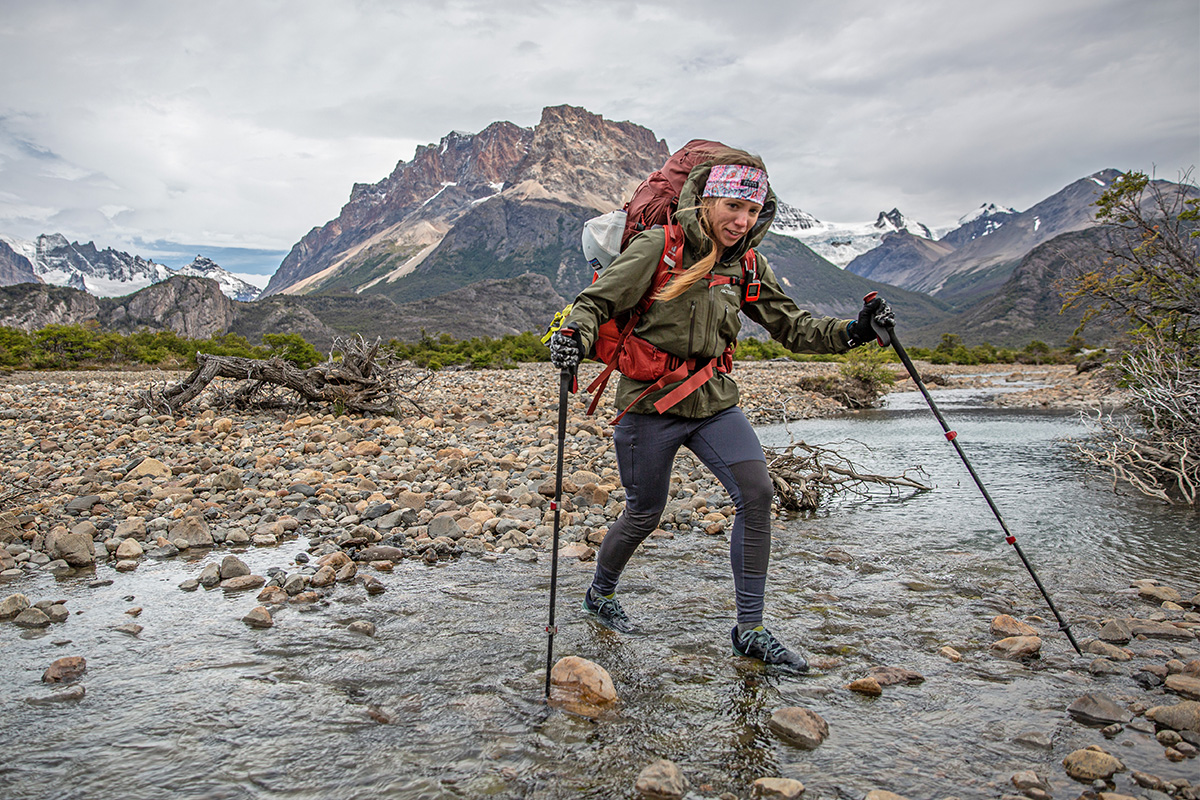
Hiking leggings are typically made out of mostly polyester or nylon, with a healthy amount of built-in stretch via spandex, elastane, or Lycra. A higher percentage of spandex will result in a stretchier feel, as well as improved mobility for high-stepping over obstacles on the trail or performing camp chores. For reference, the On Trek Tight is made with a whopping 41% elastane, making it one of the stretchiest options on our list, while the Eddie Bauer Trail Tight High-Rise Leggings feature just 12%. This translates to a noticeable step down in mobility, although leggings inherently offer better freedom of movement than most hiking pants. In the end, only you can decide how much “give” you prefer in your leggings, but we’ve hiked, climbed, and backpacked in most of the options above (including the Trail Tight) and experienced very minimal restriction to movement.
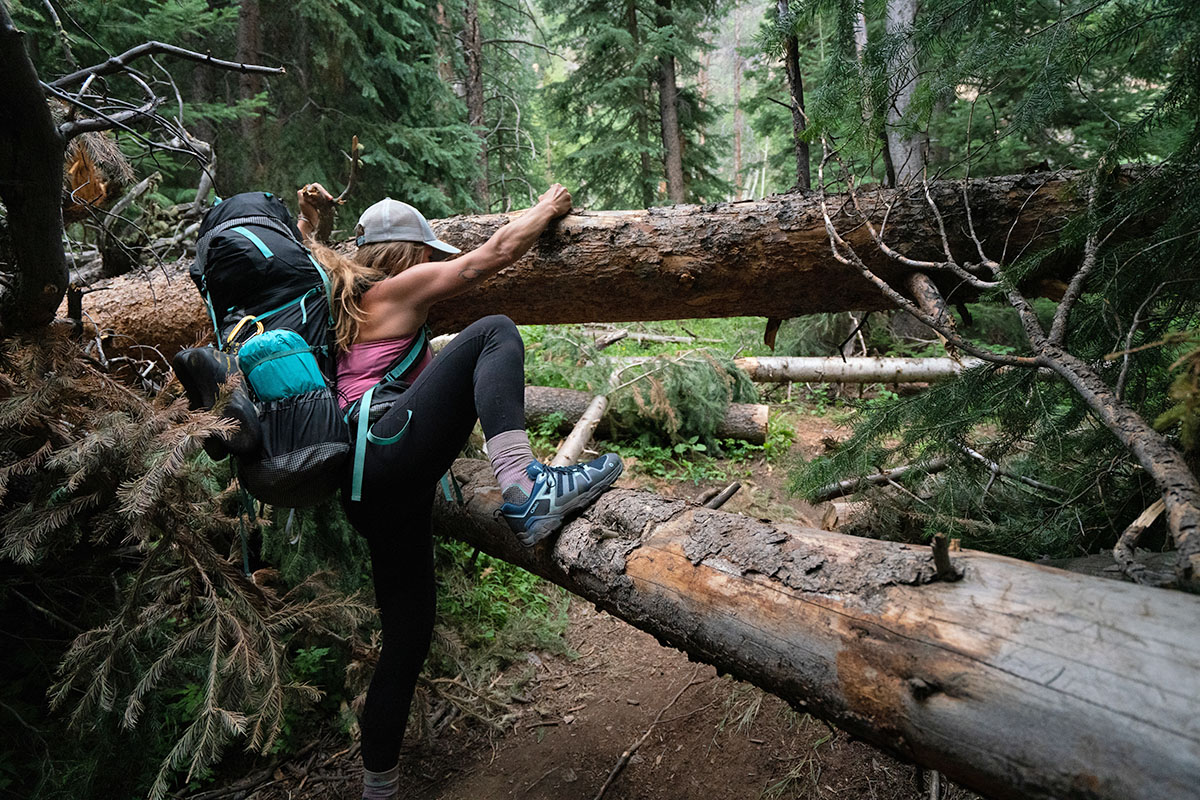
Several factors contribute to a legging’s comfort, including the width and stretchiness of the waistband, construction and material quality, and the seamlessness of the interior (to name a few). Starting with waistband design, we love wide and supportive designs—like what you get with the OR Ad-Vantage and Patagonia Maipo 7/8—that go largely unnoticed underneath a pack hipbelt or climbing harness. At the other end of the spectrum, OR’s Ferrosi Hybrid has a relatively stiff, tight waistbands that make them difficult to pull on over our hips.
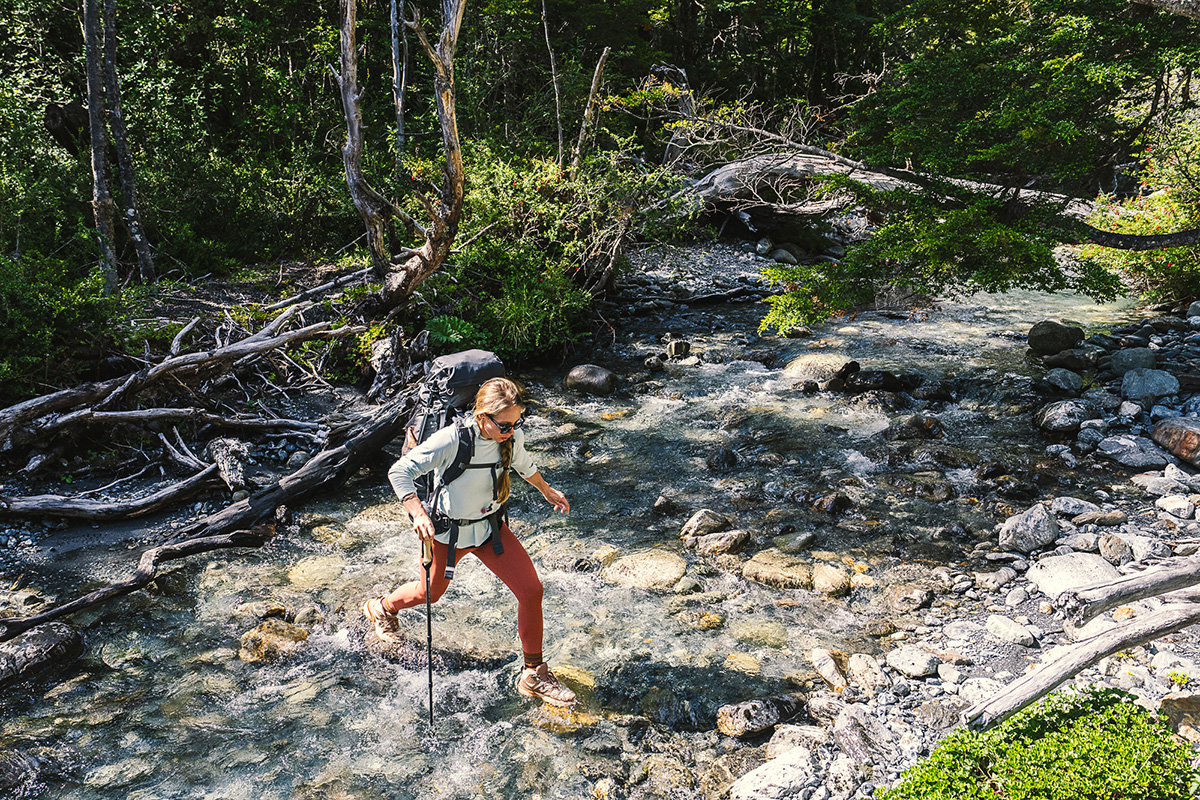
Materials also matter for comfort, with a few of the softest options we tested being the Patagonia Pack Out Hike Tights and Patagonia Maipo. On the flip side, the Mountain Hardwear Chockstone’s double-weave softshell fabric has a noticeably stiffer feel than the aforementioned tights, and the same goes for the Gorewear R5 Windstopper, with windproof panels that feel stiffer than the main body of the leggings. Finally, details like seam location matter. Some users report chafing and discomfort along the inner legs due to protruding seams in the Mountain Hardwear Chockstone. While we haven’t experienced this issue, it’s worth doing your research—and ideally trying several pairs on—before making a final decision. We did our best to call out our comfort-related experiences in the product blurbs above.
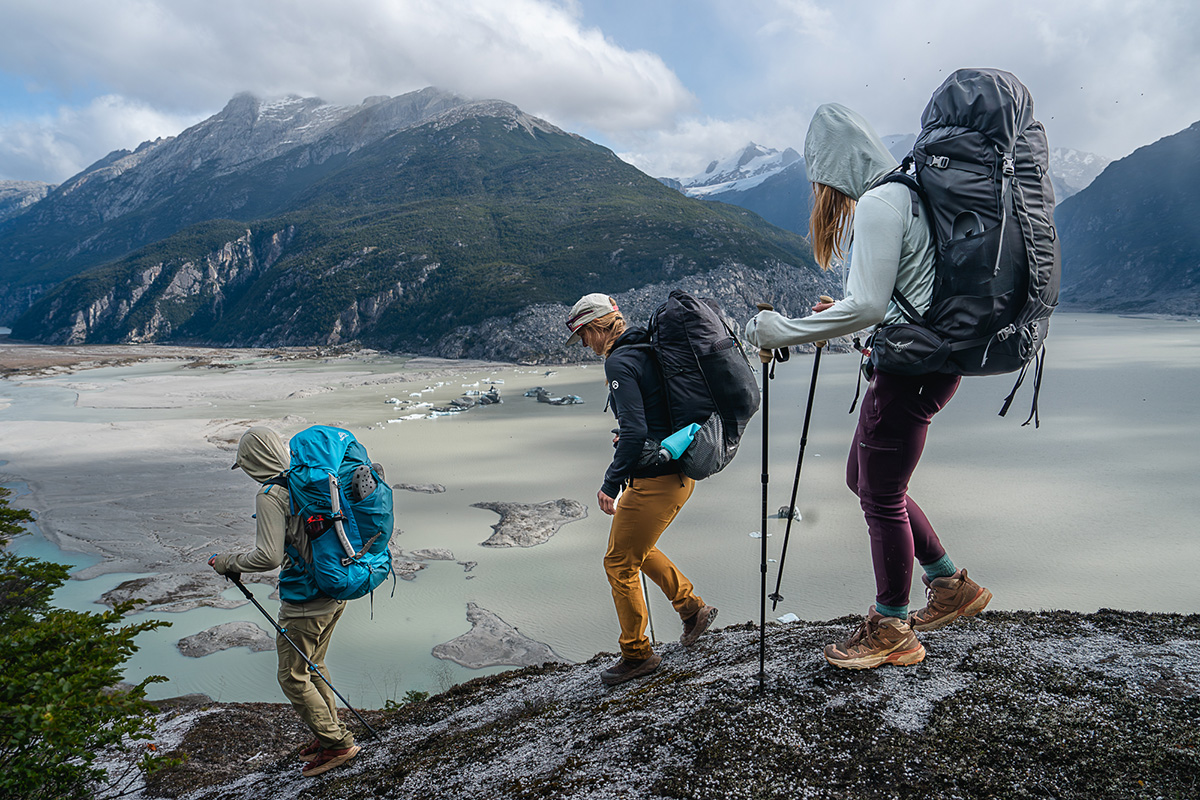
Trail-ready storage is a hallmark of hiking leggings, with technical offerings often feating an assortment of both zippered and non-zippered pockets. One clear standout above is the Outdoor Research Ferrosi Hybrid, which features four pockets that make it easy to stash keys and divvy up your phone and snacks. Other designs that feature functional zippered storage include the Patagonia Pack Out Hike Tights and On Trek Tight. While less secure than zippered pockets, drop-in pockets are more common and nice for stashing non-valuable items like lip balm or an energy bar. Finally, many leggings feature a small stash built into the waistband for storing a gel or car key—just be aware that items can fall out due to the lack of closure. And a final note: Overloading your pant pockets can lead to sagging, so we often prefer to stash heavier items like our phone in our jacket pocket instead.
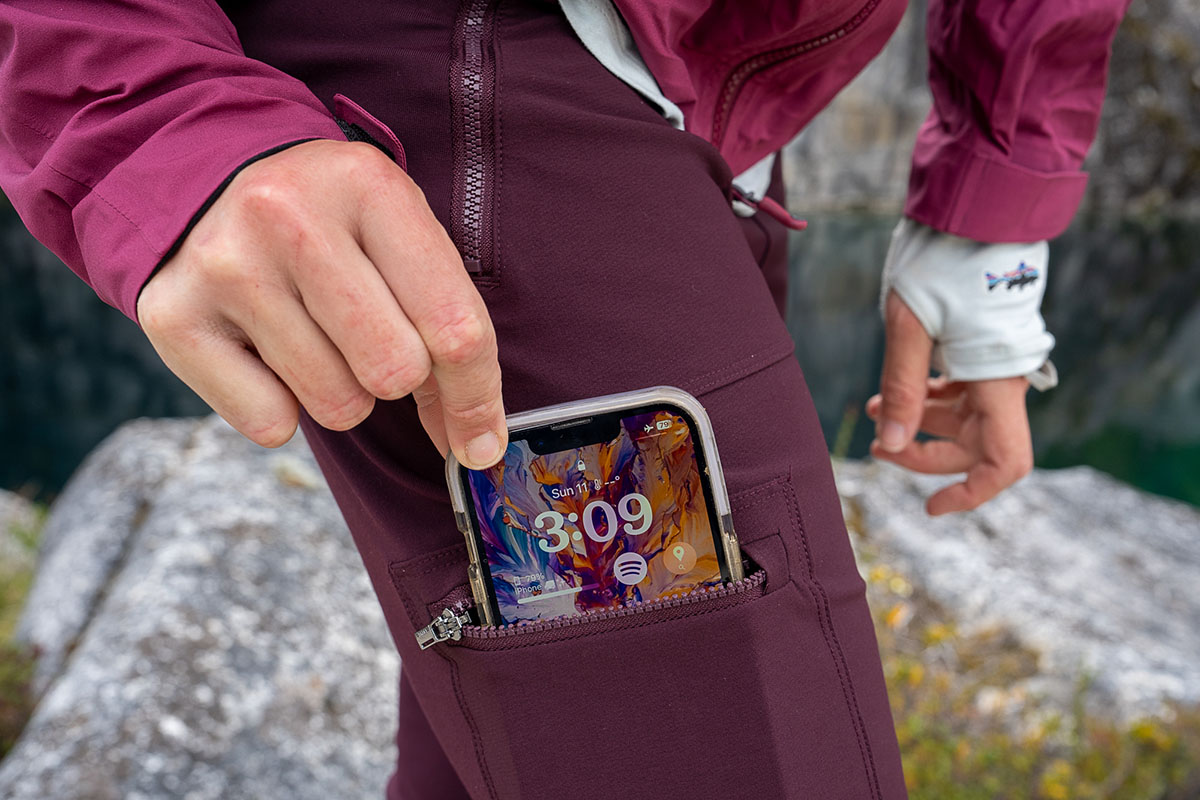
Most of the leggings above extend down to the ankle joint, resulting in very little skin exposed when wearing no-show socks. 7/8-length designs like the Patagonia Maipo, Helly Hansen Blaze, and Outdoor Research Ferrosi Hybrid ride a little higher, so you’ll need to choose your hiking socks accordingly. For hiking and backpacking, we prefer to have no gaps in coverage in order to maximize protection against brush and bugs, so we often pair our leggings with quarter-height or even crew socks that overlap the bottom of our pants. Our Gorewear R5 cold-weather tights are the longest, with a 31.75-inch inseam. It’s largely a matter of personal preference, but we’ll leave you with this: We once left less than half an inch of skin exposed while backpacking in Wyoming’s Wind River Range and came away with a ring of mosquito bites around our ankle.

Unlike other types of outdoor gear, for most hikers, the weight of their pants isn’t a top consideration (after all, you're not usually carrying them on your back). And with hiking leggings, the spread is pretty narrow: For reference, the lightest option on our list above is the Patagonia Maipo 7/8, which checks in at just 5.3 ounces, while the heaviest is the Patagonia Pack Out Hike, which is listed at 10.7 ounces. In testing the two leggings side by side, the difference in breathability was more noticeable than the difference in heft and bulk. Most designs fall somewhere in the middle, with the sweet spot being around 8 or 9 ounces. In the end, we consider weight to be a helpful indicator of performance characteristics like breathability and durability (more weight usually means thicker fabrics), but it's just one piece of the puzzle. And importantly, most leggings are lighter than traditional hiking pants, which can easily exceed a full pound.
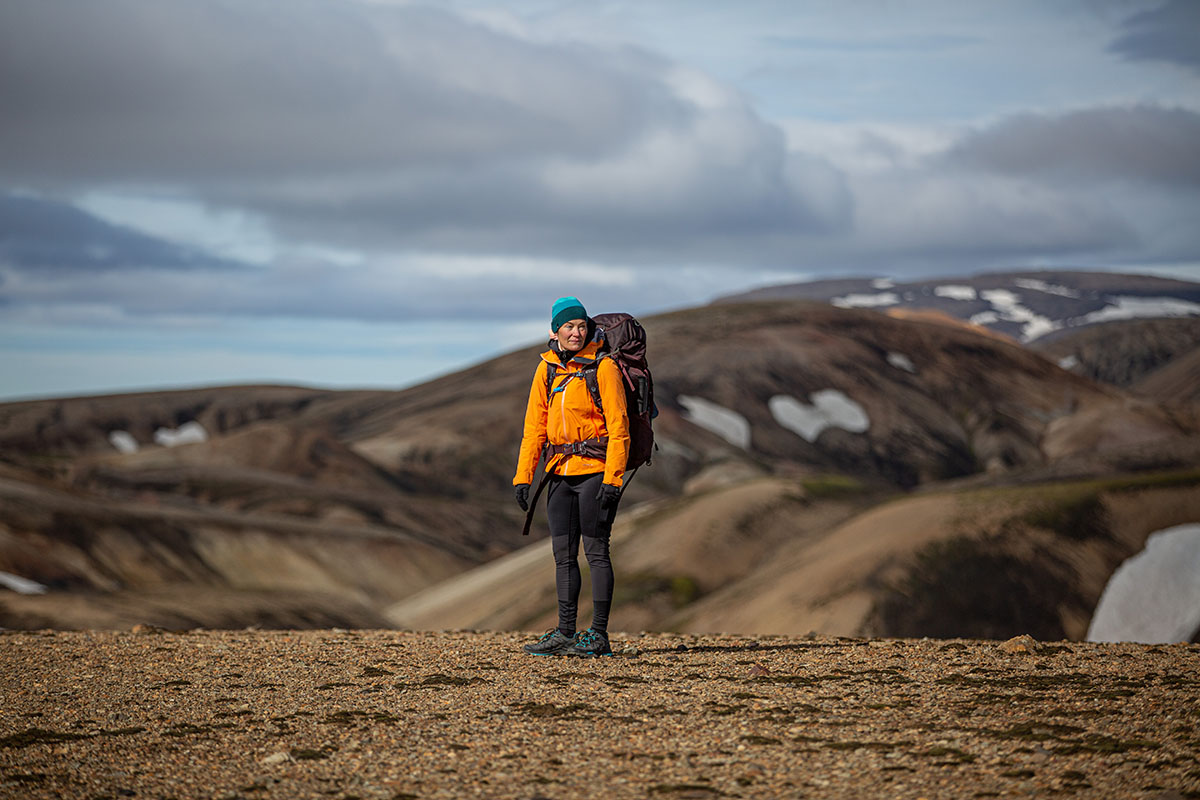
The thickness of material plays a big role in a hiking legging’s best uses. Weight can be a good indicator of this performance: From our list, options like the Patagonia Maipo 7/8 excel in hot temperatures with their thin, breathable fabrics, while heavier designs like the Patagonia Pack Out Hike Tights are better suited for mild to cool weather. Three-season versatility was a key factor in choosing our favorites, so most of the tights above fall into this category. For cold-weather uses like winter running or low-output activities in the shoulder seasons, we turn to purpose-built options like the Gorewear R5 Windstopper, which features a denser body materials and strategically placed windproof panels.
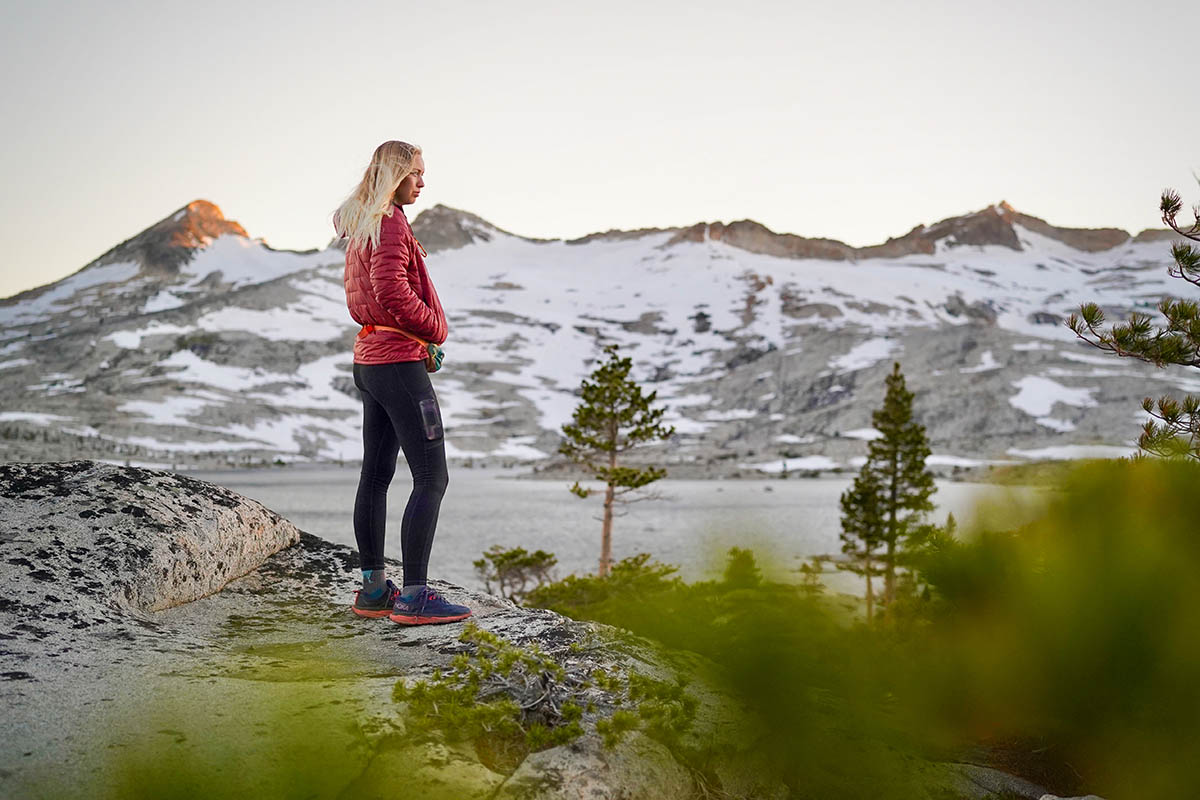
Beyond temperature considerations, thickness often correlates with durability and tear resistance. Our pair of Patagonia Maipo Tights was quick to develop pilling and snags after backpacking on overgrown trails in Patagonia, while the Pack Out Hike Tights have lasted us multiple seasons of hiking, backpacking, and climbing with virtually no wear to show for it. It’s also worth noting that reinforcements can go a long way in beefing up high-wear areas, as seen in designs like the Pack Out Hike, On Trek Tight, Helly Hansen Blaze, Fjallraven Abisko Tights HD, and Outdoor Research Ferrosi Hybrid. While less robust, the top-ranked OR Ad-Vantage Leggings also feature reinforcements in the form of overlays along the knees and hips. Before making a decision, be sure to consider your objectives, preferred terrain, and whether or not you need the added reassurance of thick fabrics and reinforced panels.
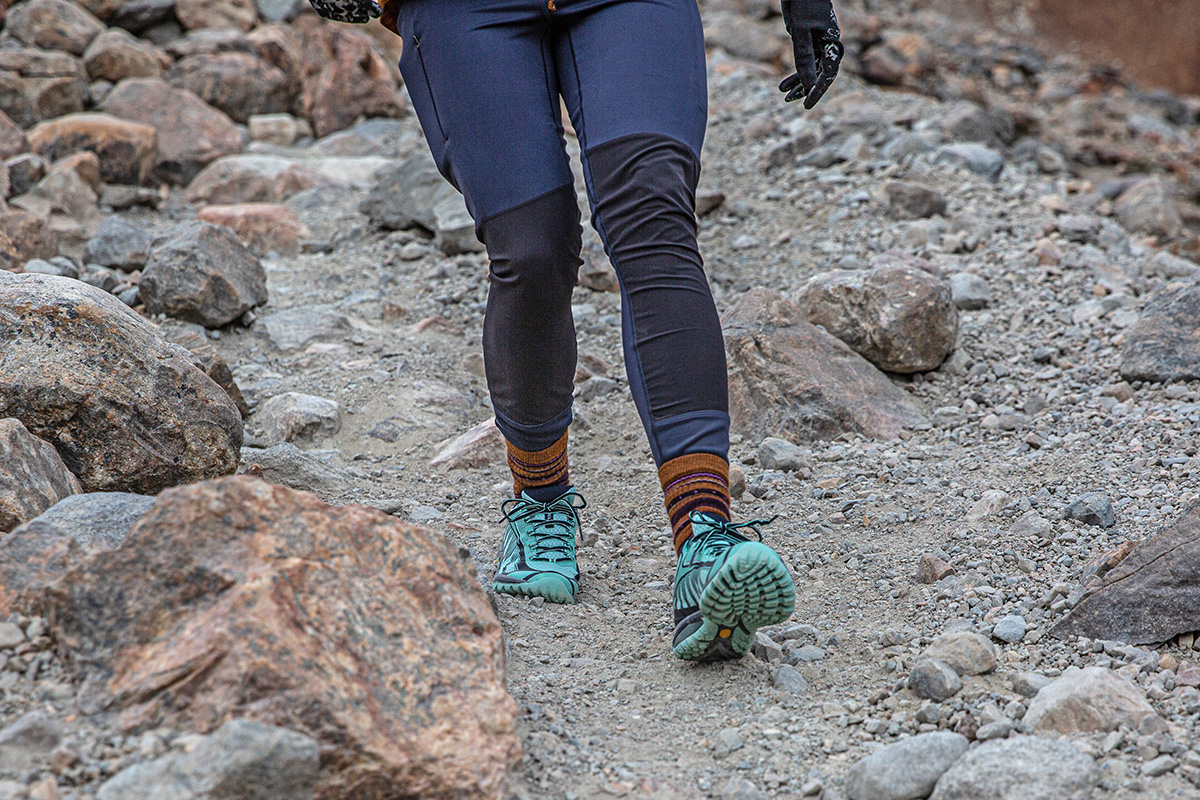
Most hiking leggings shed light rain pretty well thanks to a DWR coating that prompts droplets to bead up and roll off the exterior rather than soak through. If and when they eventually get wet, drying time isn’t too shabby, either—particularly for thin designs like the Patagonia Maipo. For this reason, we’re rarely hesitant to wear leggings on the trail unless prolonged, extended moisture is in the forecast. For many, the bigger issue will be wind resistance, with most tights offering little in the way of protection against strong gusts. OR’s Ferrosi fabric is one standout (featured at the back of their Ferrosi Hybrid Leggings), and we also found the Mountain Hardwear Chockstone pretty good at fending off wind due to its thicker fabrics (although the trade-off is reduced breathability). In the end, we typically opt for beefier hiking pants on alpine objectives and summit pushes, but most leggings will get the job done in mild to moderate moisture and wind.
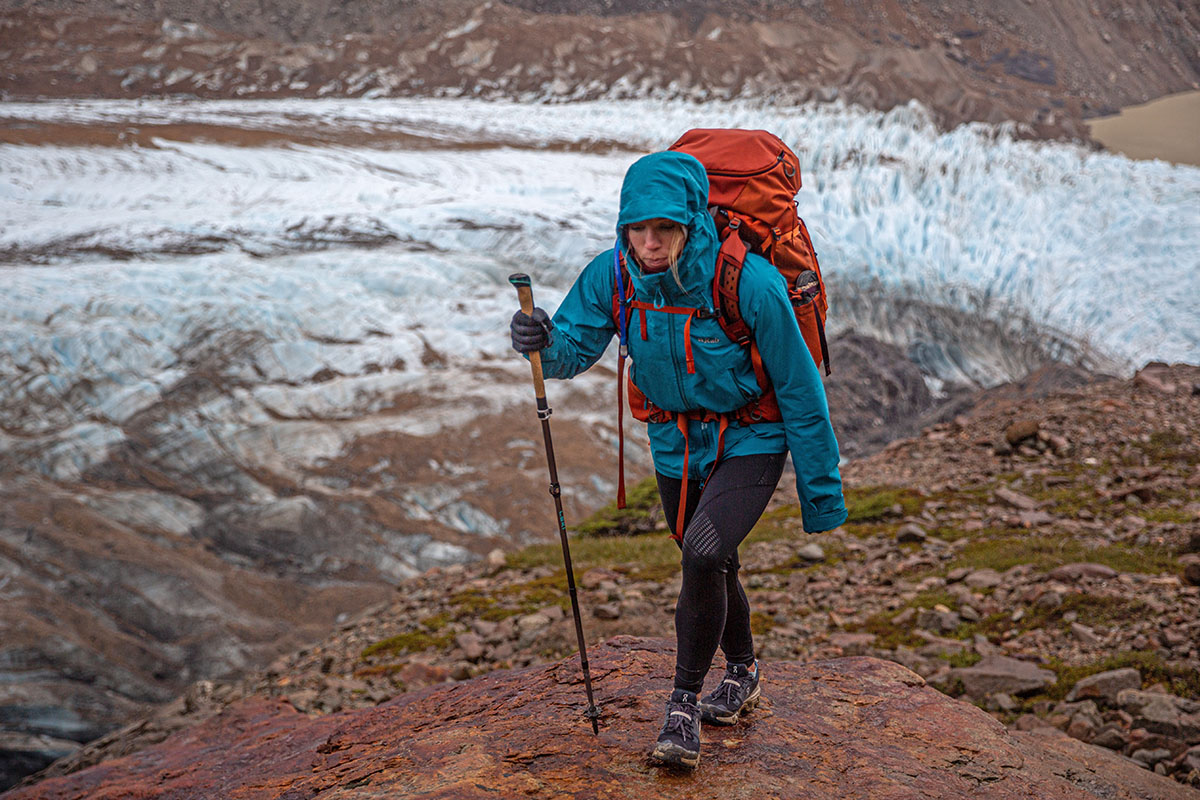
Many hiking leggings have a UPF rating, which gives an estimate of how much UV radiation the fabric allows to pass through. A UPF rating of 50 means that just 1/50th (or 2%) of the available UV rays are able to make their way to the other side of the fabric, while a UPF rating of 30 denotes that 1/30th of rays will pass through. For reference, a UPF of 15 is the lowest possible rating, and 50+ is the highest (of note: UPF 30 is the minimum rating that qualifies for the Skin Cancer Foundation’s official recommendation). And of course, if you’re wearing more than one layer, you get more sun protection. We have yet to meet anyone who’s been burned through a pair of leggings, but if your priority is maximizing sun protection, it’s worth aiming for the higher numbers. And a final note: Darker fabrics generally offer better protection than lighter designs, so be sure to take colorway selection into account if it’s a concern.
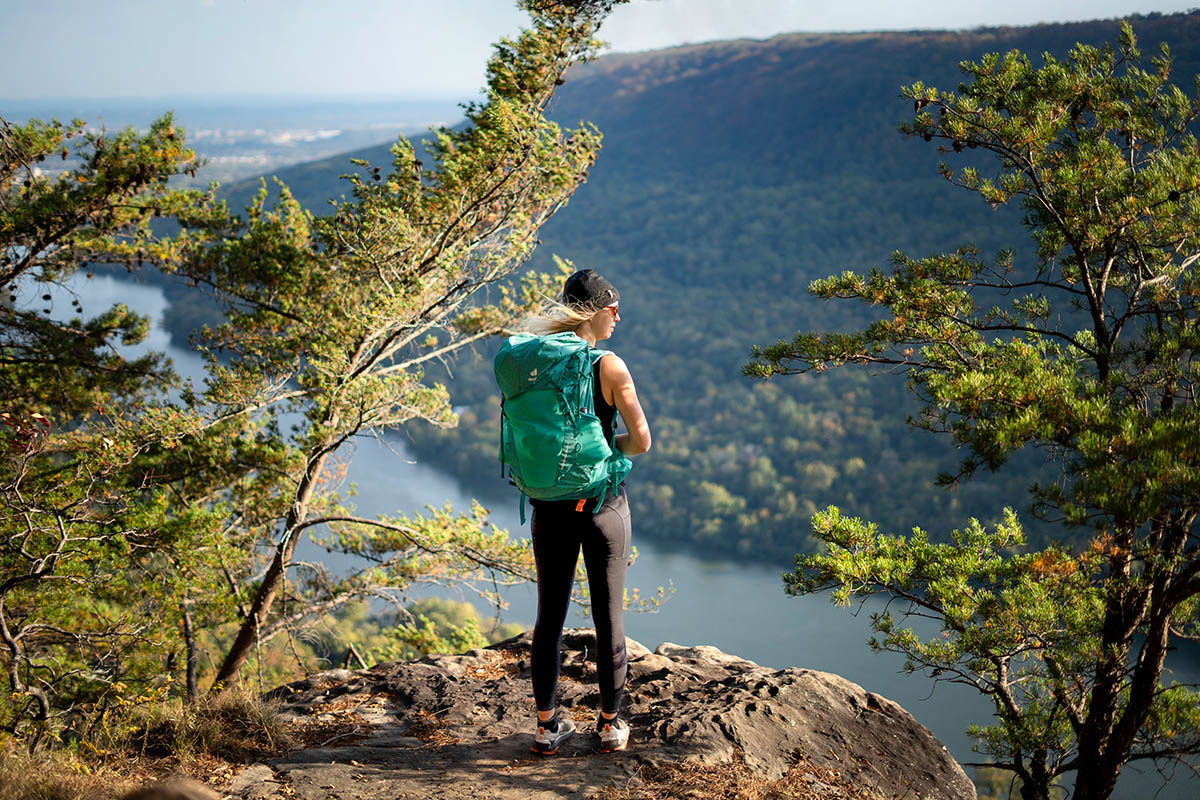
Nailing the right fit can be challenging, but the good news is that leggings are a little easier to dial in than standard hiking pants due to the generous amount of built-in stretch. In general, we look for a snug but not restrictive fit and supportive waistbands that stay in place throughout the day. To accommodate a wider range of body types, we appreciate when leggings are offered in multiple inseam lengths, like the Eddie Bauer Trail Tight High-Rise Leggings (sold in petite, regular, and tall inseams, as well as plus sizes up to 3X). Finally the Helly Hansen Blaze features an internal drawcord for cinching the waist. We did our best to call out sizing and fit discrepancies in the product descriptions, but we always recommend trying on before you buy.
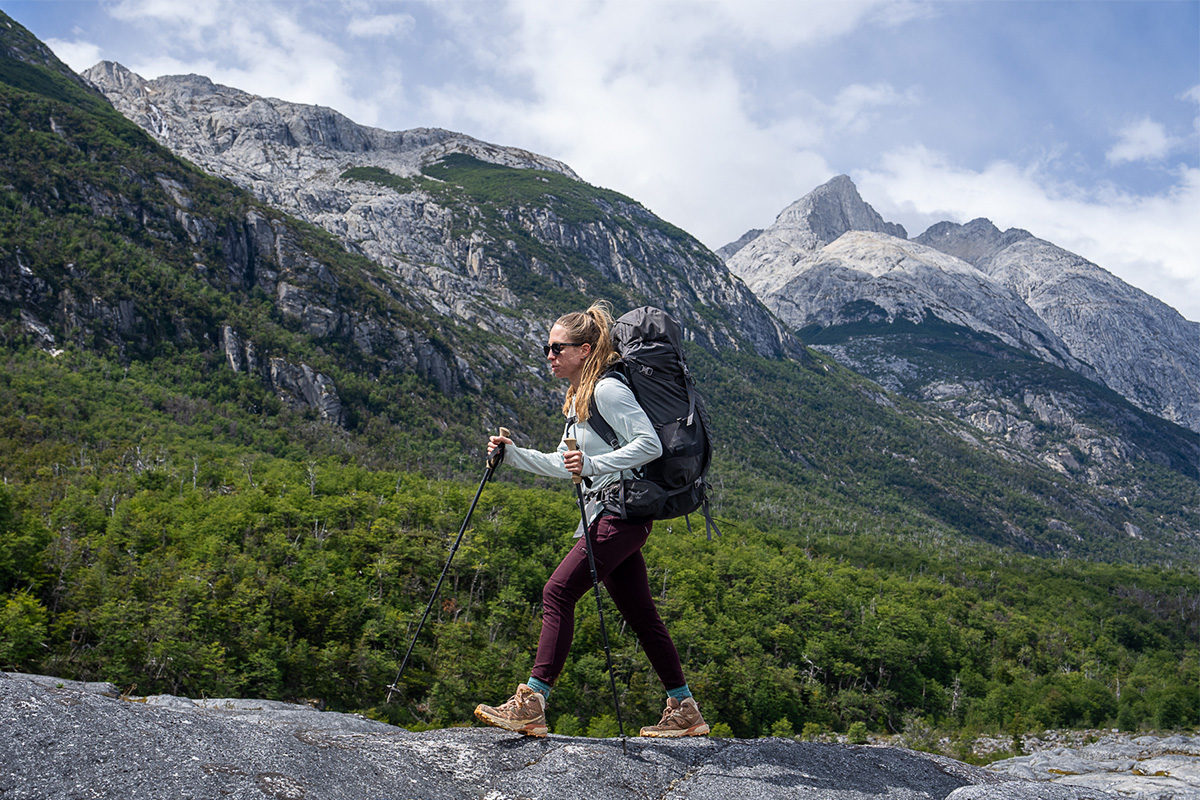
We appreciate when companies go the extra mile toward creating more sustainably built products, and the most common practice in the hiking legging world is the use of recycled fabrics. Many of the picks above are made with at least some recycled content, including designs like the Fjallraven Abisko Trekking Tights HD (70% recycled polyester) and On Trek Tight (partially recycled polyamide). Patagonia takes things a step further with their Maipo 7/8 Tights, which utilize nylon sourced from recycled fishing nets. Other measures to look out for include certification to the Fair Trade standard, bluesign-approved materials, and PFAS-free DWR coatings that forgo the use of harmful per- and polyfluoroalkyl substances (the Pack Out Hike Tights check all three boxes). The good news: Most of the companies above have started incorporating at least some of these practices into production.
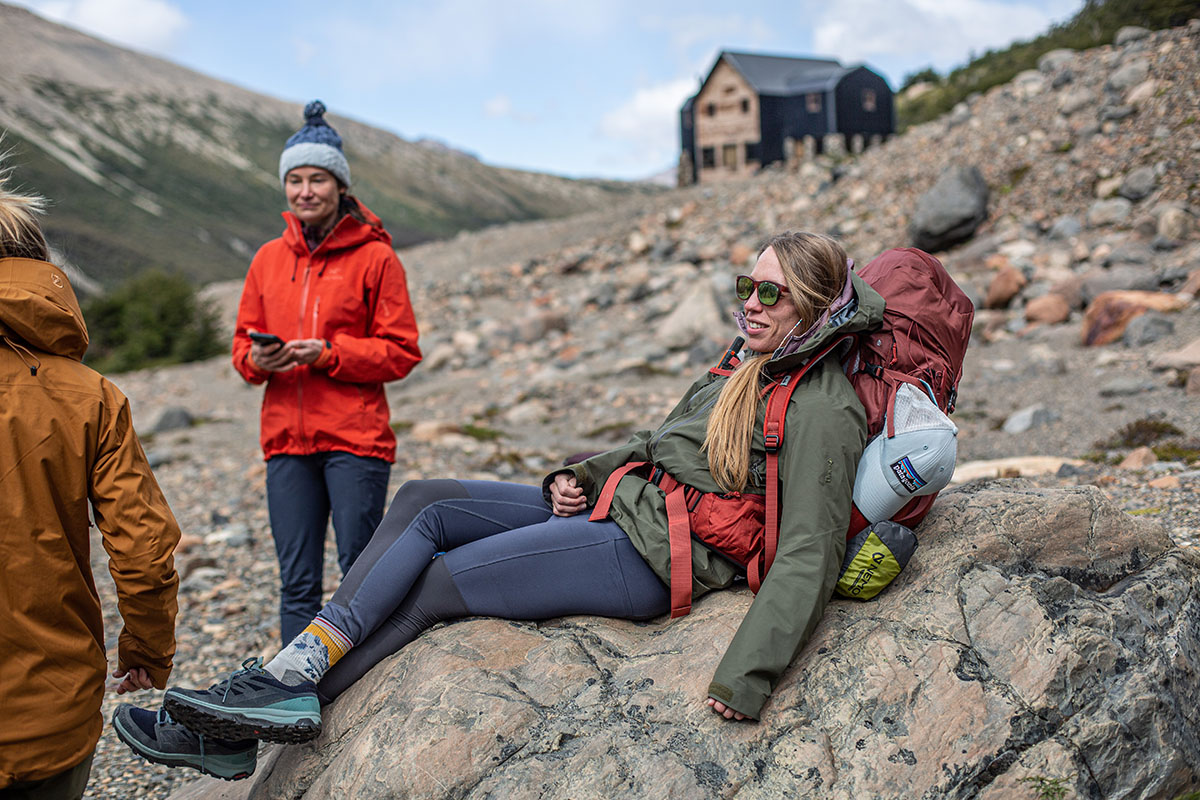
The choice to wear leggings or pants is a largely personal one, but there are a few considerations that may sway your decision. First, tights are generally less durable and more prone to snags and pilling than traditional hiking pants, especially if your hiking objectives often involve bushwhacking or scrambling. While many feature DWR coatings for fending off light moisture, we’ve also found leggings to be less weather-resistant compared to hiking pants, especially when it comes to fending off strong winds. And due to the close fit, you can expect to give up a fair amount of breathability with leggings, although lightweight designs like the Patagonia Maipo are airy enough that we’ve managed to stay comfortable into the 80s Fahrenheit. Finally, leggings generally offer less storage than hiking pants, although there are plenty of technical options that make it easy to stash essentials like a phone, car keys, and snacks.
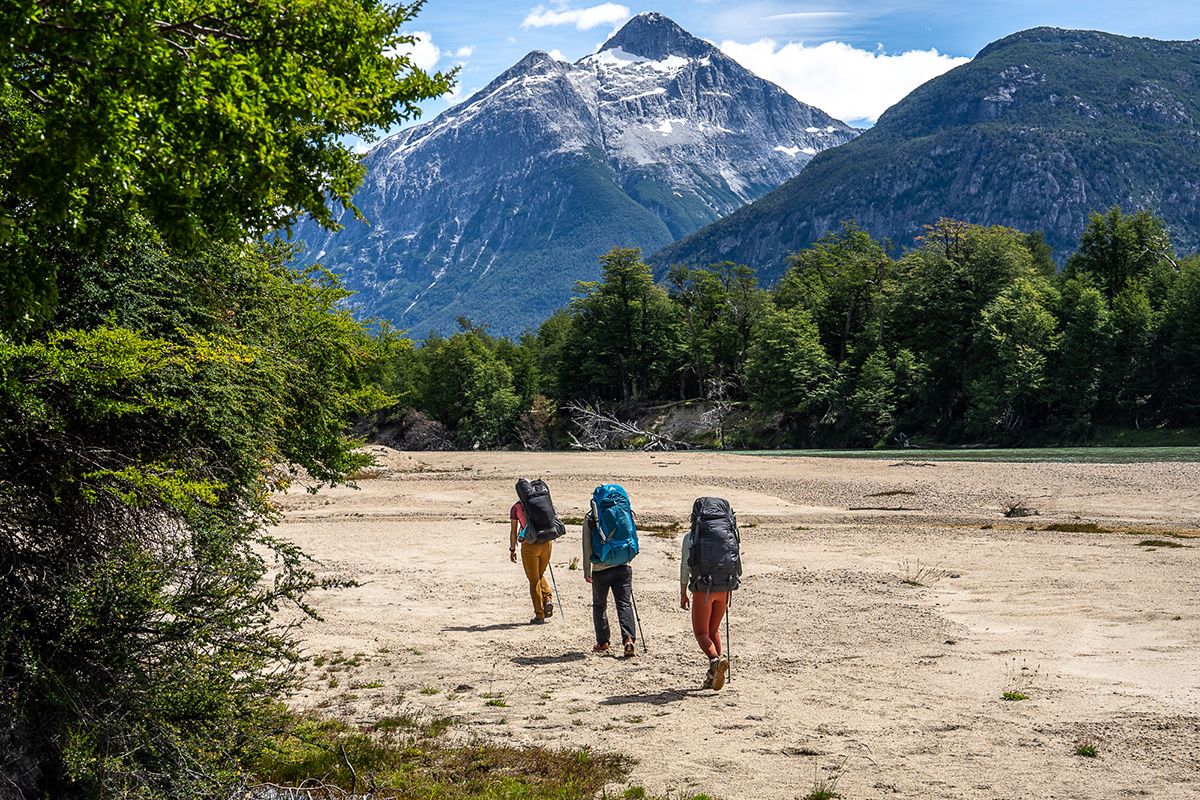
Leggings’ biggest advantage over hiking pants is their unparalleled mobility, which is a result of their snug fit and generous use of spandex or elastane. We also like their wide, closure-free waistbands that go largely unnoticed underneath a pack hipbelt or climbing harness (hiking pants’ buttons, drawcords, and other hardware can lead to discomfort). In the end, we often tailor our pant choice to the specific objective and expected conditions, so it’s worth having more than one option in your closet. For a full breakdown of our favorite pant options—including a mix of traditional pants, joggers, and leggings—see our article on the best women’s hiking pants.
Back to Our Top Hiking Legging Picks Back to Our Hiking Legging Comparison Table